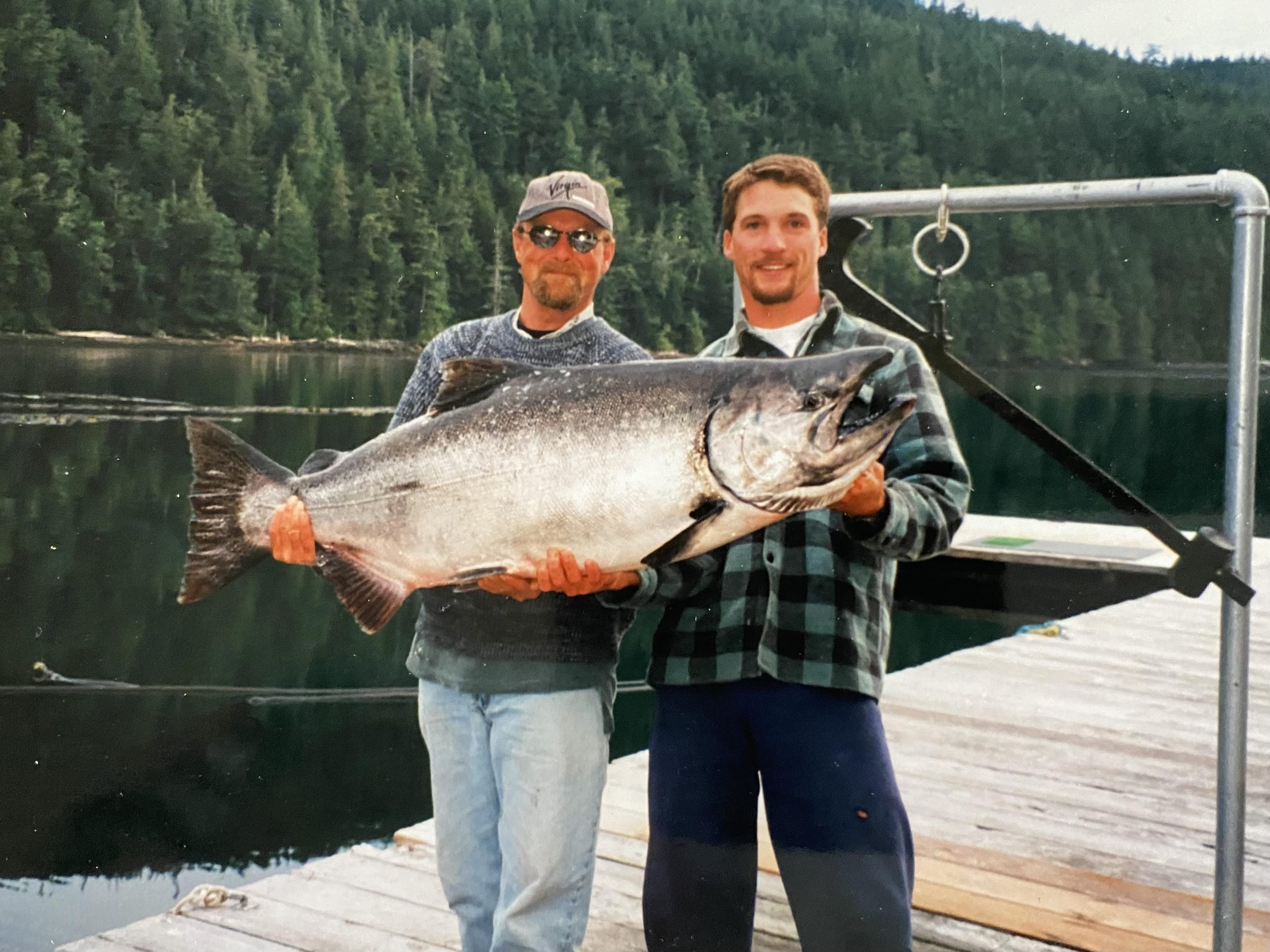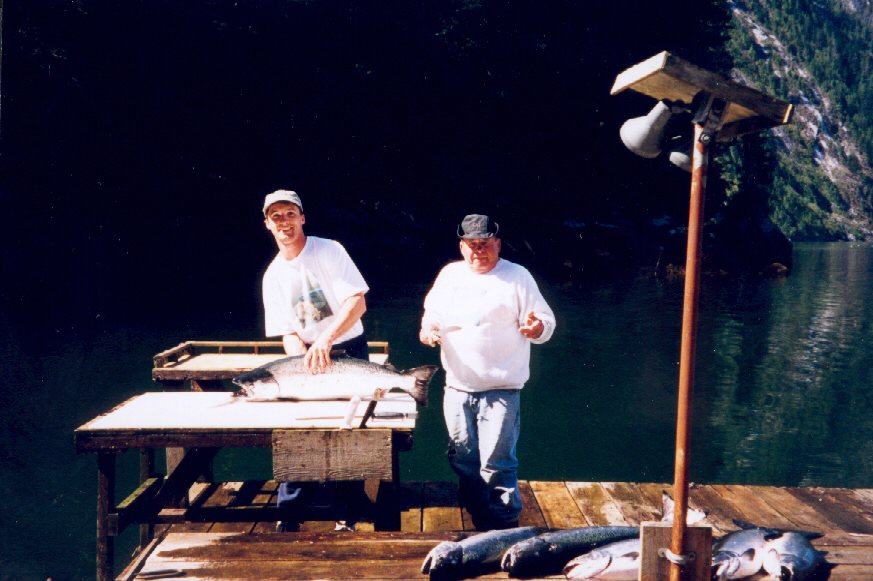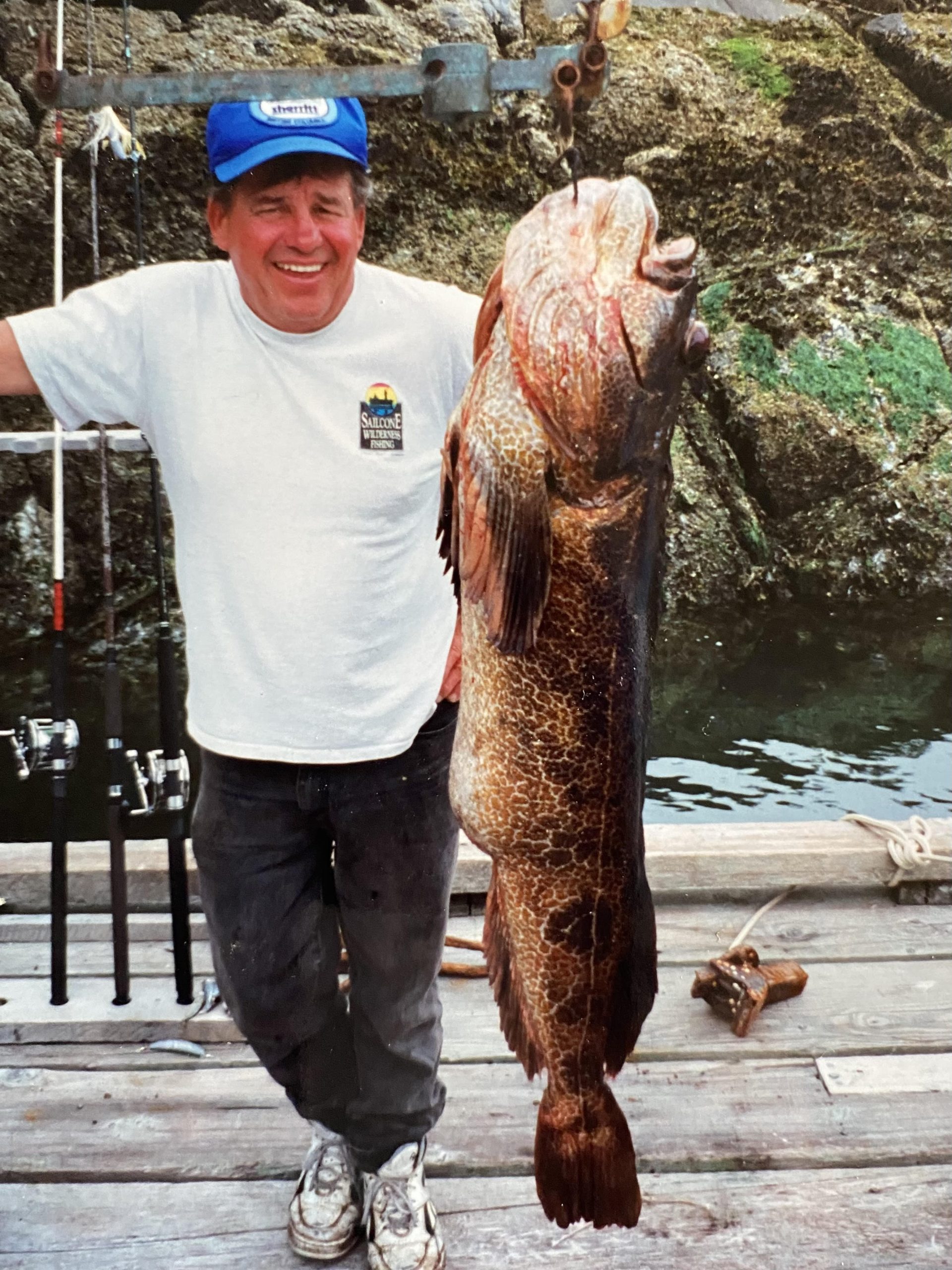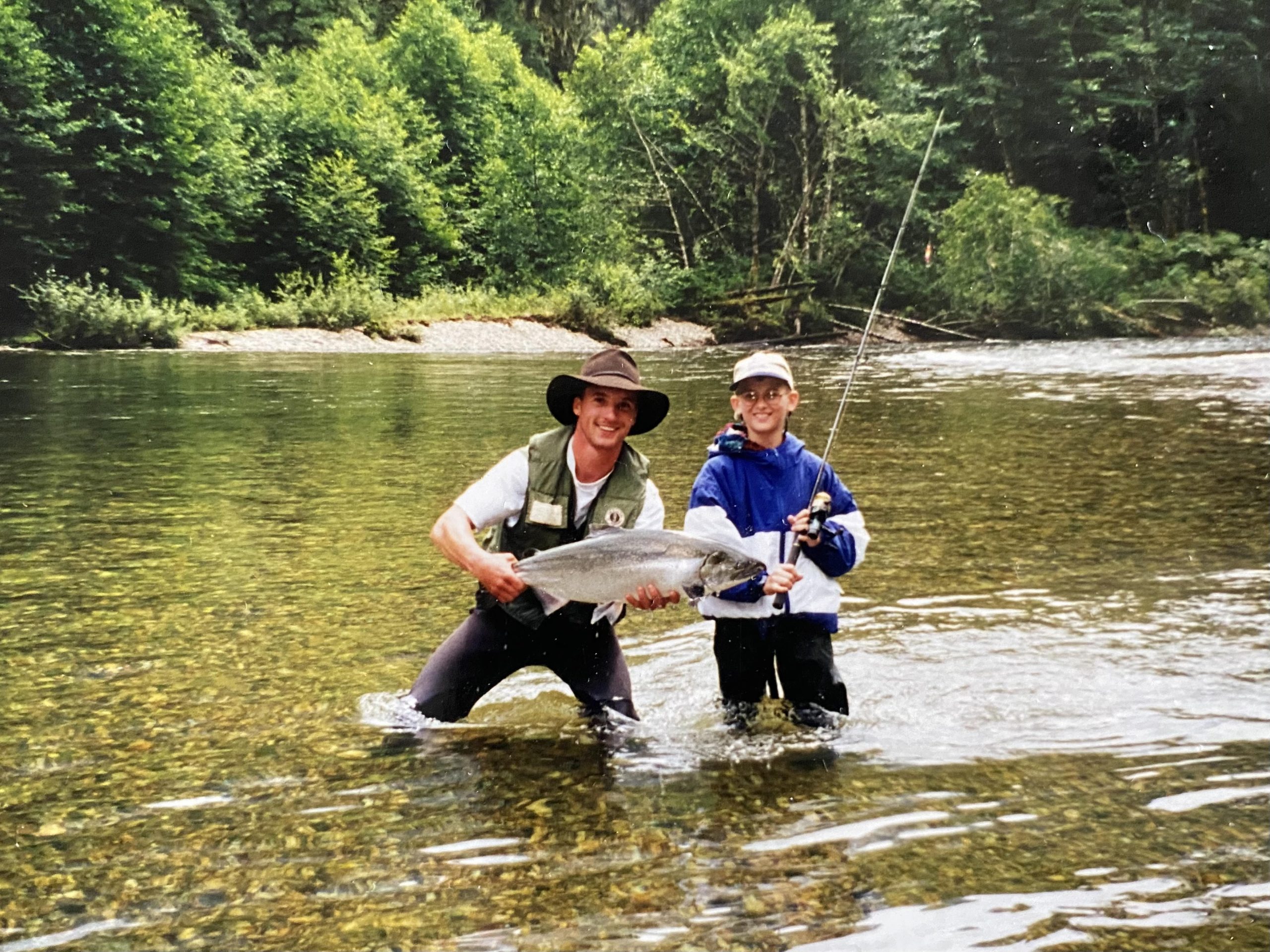James Mace began working for our lodge as a teenager in 1992, back when the lodge a part of Sailcone Wilderness Fishing. He has always been a favorite for every guest that has been through his boat over the years, working 7 full time seasons in his early career and making his triumphant return to us last year, in 2024. James’ blood and personality are in the float, and nearly every long-time guest who fished with us during his long sabbatical from Coastal Springs has wanted an update on his life and to know when he would be back.
The love James feels for this place is the same so many of us feel; having grown up here either literally or figuratively, having been shaped by the place and having learned to fish, work, and be changed. In response to James’ return, he was stirred to write about his experience at the float lodge from his first season to now, outlining summers of fish, bears, and a life different than most.
-Cam
“The Sailcone Experience”
By James Mace
I was born and raised on Vancouver Island in Victoria, the Capital of British Columbia. Much of my family, immediate and extended, were outdoors people. From a very young age I was exposed to and became enamored with the wild and rugged beauty of the west coast. As a pre-teen, I would read books by Haig Brown, Charlie White, Lee Strait, and many other authors documenting their fishing experiences across British Columbia and abroad. I would read of Campbell River; the “Salmon Capital of the World” as it had become known in that era, due to its run of large chinook and its elite “Tyee” club. I would read of the many fishing lodges and the fishing guides who’s career it was to take people fishing and get paid for it! To a young boy though, Campbell River seemed untouchable, too far away to ever get to. A three-hour drive. But still, I could dream.
As luck would have it, through a series of connections in Junior High school, my name was passed on to founder and owner of Sailcone Wilderness Fishing, John Reid. This happened thanks to one of my teachers at the time, Doug Carter, still a close friend to this day, and the school administrative assistant, Arlene Phillips (John’s ex-wife). Unbeknownst to me, John contacted my parents in 1991 when I was 16 years old, to see if I would be interested in spending the summer working for him in Knight Inlet. I would have loved to; however, my mother wasn’t ready for me, her youngest, to leave the nest quite yet so my employment there was delayed one more year.
John tracked me down the following spring of 1992 when I was 17. The plans were set and on June 30 my parents drove me to Campbell River where I would board a DeHavilland Beaver float plane with co-owner Steve Kelly and take flight to what would turn out to be the start of some of the most influential years of my life.
We landed in the middle of Knight Inlet, somewhere between Hoeya Head and Minstrel Island as Sailcone’s Float Lodge (renamed Coastal Springs Float Lodge in 2003) was on its way to its summer location at Pitcairn, Cracroft Island. The next day, we got right to it. The other wharf-rat at the time, Derek Hutter and I ran ahead of the lodge with two boats full of poly water line and we spent the day piecing together the several hundred yards of pipe through the forest and along the beach to where the lodge would end up. Once the lodge was safely secured in the small bay between the two rocky points, we had some time to relax. I immediately set up a rod with a live perch for bait and caught my first Sailcone fish; a large lingcod of about 16 pounds, right from the dock. Steve, John’s partner and the boss at the Float Lodge informed me he didn’t like to eat fish and suggested that I release it, which I did. The following days included a variety of chores around the float, as well as another trip down the water line to repair some pipe that had already been chewed up by “Loyd” the bear.

I then headed down to Sailcone’s Minstrel Island Lodge, where I would spend the majority of the next two months. I quickly got into the swing of things; the continuous cycle of float planes in and out every four or five days, swapping out groups of guests. The chores were plentiful, helping guides with their catch, cleaning docks, gassing up boats, setting and clearing the dinner table etc. Changeover days, when the plane would drop off new guests and simultaneously pick up the previous guests, were hectic. Changing beds, doing laundry, cleaning rooms, cleaning and cooking crab, packaging the group’s catch, all on top of the regular daily tasks.

Our first group at Minstrel was 10 guests – maximum capacity for the lodge. Kari Reid was the cook and the guides were John, his son Kelly (Kari’s husband), Darcy, Allan (who had come to the lodge straight from a hiatus teaching English in Japan) and the legendary Bud. I still remember Allan, severely jet-lagged sleeping through the 4:00 AM wakeup call the first morning. He was on the top bunk, and I reached up to shake him awake. He came up swinging, eyes wide open, screaming something in Japanese.
Fishing was good and everyone was returning with fish or fish stories nearly every shift. Only a couple days in, John himself returned from Cleave point with a 43 pounder that he caught on one of the ugliest plugs known to man and salmon that we dubbed “Kermit”.
Occasionally, we would have a short break between groups to relax. While most of the guides who had been working since the spring got plenty of rest, I went fishing. I was young and green, but I was keen and with the help and guidance from the other guides, I quickly started catching fish. One of my first Sailcone salmon was a 29 pounder from the bluffs across from Cracroft point thanks to Derek Hutter who was running the boat. I think that is still the second biggest chinook I ever reeled in myself in that area.

As I got used to my daily schedule of chores, I became efficient at getting things done, to the point that if there was an extra boat available, I could sneak out fishing on my own now and then. As is always the case, the fishing fluctuated, and I got skunked as often as I caught fish – showing inexperience. Eventually I became consistent enough that John decided to let me do some sporadic guiding, mainly in the afternoon so he could get some extra rest and/or get some other lodge maintenance done. My first trip out with guests was the evening of July 20, just around the corner from the Minstrel Island Lodge in the Serpentine. I remember one of the guests looking at my 17 years old face and asking, “So how long have you been doing this?” Having always been a bit of a smart-ass, I replied, “Well what time does your watch say?” to which he raised a brow… Fishing was slow that night: we lost one decent spring and released one about 6 or 7 pounds.
A couple of the guests in that group were Jack and Betty Wilkinson, who were the Sailcone liaisons in Vancouver. They would meet the incoming guests there as well as make sure any last-minute food and supplies made it on the plane. Each year they would get to come to the lodge for the all-inclusive experience. Sometimes Jack would “self-guide”, which often turned into a comedy of errors. Stories of trolling flashers backwards, using hoochies with no flasher, and returning with a boat load of creatively identified salmon. Thus, John decided this would be a good opportunity for me to try out guiding full-time. The first day was relatively unproductive; a couple of coho landed and one good sized spring lost. The second day things picked up for everyone, and I managed to get Jack and Betty a couple of nice springs, 21 and 28 pounds at the kelp reef off the triangle marker at White Beach, which would quickly become one of my favorite spots. The following day we returned to the same spot where I guided my first two tyee, a 33 pounder and a 42, that took over an hour to net. We also landed a beautiful 14-pound coho the same morning.

On went the summer, a constant mix of jobs, guests, guides, weather, and fishing. I was truly in my element. It wasn’t until August 20, when I knew that I would be going home on the 23rd, that I finally called home, almost two months after I had left. Now that I am a parent, I am truly ashamed that I didn’t make the effort to contact home sooner, and more often, especially since only a few years earlier I had a near death experience sinking a boat in the middle of Cowichan Lake. I’m sure mom did a lot of worrying about me being away on the ocean and I know she lost a lot of sleep that summer.
Leading up to my final day, I had asked John if I could take some guests fishing. He kindly obliged. It was a great end to my first summer at Sailcone, and the fishing had been good up the Inlet, so we took the boats to “The Cairn” across from Hoya Head. This was my last journal entry for that summer:
“What a finish! My last trip out guiding and we got 6 fish, 3 springs and 3 coho. The biggest was 38 pounds, my third guided tyee. Awesome! What a beautiful morning to get to go out. Flat calm, sunny, saw a bear and some porpoises and caught some fish! That made my whole summer, to be able to go fishing on my last morning and catch another tyee!”
That was the first of 7 seasons that I spent full time at Sailcone. Unfortunately, I didn’t keep up with my detailed diary as I had done that first year, but there are still many memories that stuck with me:

I’ll never forget Derek and I having to dig out the water hole at Pitcairn at the beginning of my second summer there. We had anchored our boat up a bit off the beach, trying to compensate for the dropping tide. However, when we returned several hours later, we found the tide much lower than expected, and our 17-foot Double Eagle stuck on a big rock, several feet above the tide line. Without many options, and not wanting to wait another 4 or 5 hours for the tide to come back in, I reluctantly climbed aboard. The leg of the motor was hung up on the rock preventing the boat from sliding down. I raised the motor with the hydraulic tilt, and the boat launched headfirst into the water. There were some scratches from the rocks and barnacles, but no major damage. We returned to the Minstrel Island lodge to a stern lecture from John. It turns out one of the neighbours had seen our boat high and dry and had notified him on the VHF radio before we got back.

Waterline was continually a wharf rat’s nemesis, constantly damaged by bears, deadfall, and storms. One spring day at Cleave point after a big rainfall we had lost water pressure and Bud had taken me in the tin boat to the shore where I could hike up the water line and figure out the problem. As I was re-rigging the end of the line, standing in the rushing creek I got that eerie feeling that I was being watched. Looking over my shoulder I saw a very small black bear cub sitting at the edge of the creek only 10 or 15 feet away. Just as I started to comprehend the situation and wonder where this little guy’s mom was, she came over the hill and locked eyes with me. She instantly charged and I bolted out of the creek and up the hill as fast as I could. I climbed out on a fallen tree overhanging a cliff to catch my breath – fortunately the bears were nowhere in sight. I can only assume the cub was so young that momma bear didn’t want to leave him far behind. When she saw that I was rapidly exiting and no longer posing a threat to her baby, she retreated to her young one and left me alone. The smell may have also deterred her.
Bears eventually became a part of my day-to-day in way I had not anticipated. At the Minstrel Island lodge, my parents, my wife Katrina, John, Cathy, Cam, Angus, and fellow wharf-rat/guide Mikey Nelson were having dinner as we noticed a black bear swimming across the channel towards us. Knowing that a bear on the small island would likely become a problem, attracted by the scents of good food and fish around the lodge, Mikey and I jumped in a boat to try and cut the bear off and redirect him back across the channel. Well, the bear didn’t want anything to do with that, and as I circled the boat around between him and the island, he let out a growl and swatted the bow of the boat with his paw, leaving claw marks in the fiberglass! We didn’t manage to turn him around, but he got the point as we never did have an issue with him.
While the fishing, wildlife, and constant work took so much of my time, it is the people that have stuck with me the longest. Those who ever had the pleasure of meeting Bud will likely never forget him. Bud was a wealth of stories, information, and advice; some good, some bad, but mostly hilarious. One of the first things Bud ever told me was “Whatever they ask you to do, make sure you screw it up, so they won’t ask you again!” Bud was notorious for “incidents” out on the water. On one occasion, Bud had a guest fight a yellowtail rockfish for 30 minutes out in the rip off Cracroft point, convinced it was a Tyee. Another time he and his guests missed breakfast while they spent over an hour battling a piece of kelp that they thought was a halibut. All kidding aside, Bud caught his share of fish, and to this day he produced the biggest lingcod I have ever seen, 47 pounds.

Obviously over so many years, there are so many great stories and memories, too many to recount in detail. My trips up the Kakweiken river with Trapper Rick were highlights, although I have one “not fond” memory of the angry loggers showing up looking for their truck I had inadvertently stolen… So many amazing wildlife experiences that we often take for granted, but for so many people would be once in a lifetime experiences, whales, wolves, cougars, black and grizzly bears, mountain goats.

For many years following my full-time seasons, I did get up now and then either as a “Guest Guide”, for a “Tool Toss”, or with friends and family to enjoy the Lodge and the area. I learned many things there. I learned about work, about people, about myself, and of course about fishing. I’m not big on cliches, but the place is truly a part of me. There is still a group of us that have worked there over the years that stays in touch. Some even continue to get up for a group or two of guiding each summer. It is a very diverse group of personalities, but we share the very strong bond of not just fishermen, but Sailcone fishermen. We continue to find eachother for various reasons, but mostly, to fish. For us, “The Sailcone Experience” continues in Coastal Springs.

Many thanks to John and Steve for hiring me all those years ago; to John’s sons Cam and Angus for continuing the legacy and continuing to extend the occasional invite. To all the cooks, guides and wharf-rats that I had the pleasure of working with; and of course, to all the guests, many of whom have returned time and time again, and became more than just clients, but friends.
Knight Inlet rules.
James Mace.